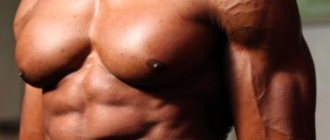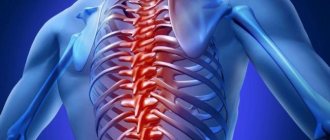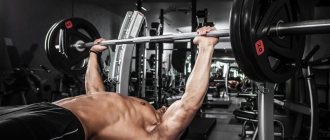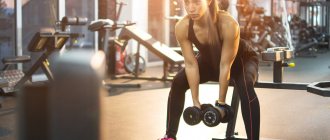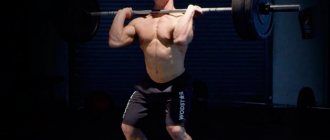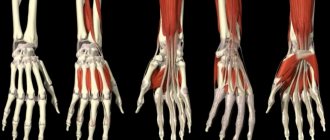You can pump up your breasts in different ways. One of the most effective is to do dips. Find out more about it!
You can pump up your breasts in different ways. One of the most effective is to do dips. However, it is not enough to just do this exercise; you need to adhere to the correct technique. Only then will you be able to pump up your chest on the uneven bars and achieve impressive results in the shortest possible time. Otherwise it will take a lot more training. And it is far from a fact that their quantity will compensate for the quality and lead to the desired effect.
How to properly and safely pump your chest on the uneven bars
- The first thing you need to start with is to understand the fact that parallel bars put a lot of stress on the ligaments of the deltoids and triceps, as well as the collarbone , so before doing push-ups, you definitely need to do a full joint warm-up of the upper body and stretch the target muscles.
- Apart from this, you need to start the exercises with a warm-up approach . This hike is performed without weights and, importantly, with a gradual increase in amplitude.
- The first repetitions should be lowered on the hands to an angle of 45 degrees in the elbow joint, and closer to the fifteenth repetition, push-ups should be performed with full amplitude . It is also very important to monitor your sensations. If pain appears during the exercise, you should stop and, after a pause, repeat the exercise. If pain recurs, dips will need to be replaced with alternative exercises.
- For the pectoral muscles, you need to perform an exercise with an emphasis on the target muscles. You can achieve increased load by tilting the body forward , in which the upper torso assumes an almost horizontal position.
- Also, to enhance the emphasis on the chest muscles, the position of the hands on the uneven bars should be wide ; this can only be achieved if you have bars of a suitable design that have an extension of the crossbars. But, without having them, you can still create an emphasis on the chest muscles by moving your elbows to the sides.
- Another important point is the shift of the load to the middle or lower part of the pectoral muscles. The middle part is better worked when the body is tilted, and the lower chest works more when moving the arms forward.
So, let's look at the types of push-ups on the uneven bars for training the pectoral muscles.
Features of working with the pectoral muscles on the uneven bars
Now let's figure out how to pump up the pectoral muscles on the uneven bars:
- The wider the bars, the wider you will spread your arms, and accordingly, you will increase the load on the pectoral muscles. With a wide grip, the chest will stretch more at the bottom.
Correct execution of the exercise: slight forward bend
Advice! If you do not fully extend your elbows when performing this exercise, you will be able to provide a load on the muscles throughout the entire session, with virtually no load on the triceps.
- You also need to monitor the tilt of your torso. When performing exercises, the body should be slightly tilted forward and down. In this case, you will better feel the work of the pectoral muscles, and therefore increase the effect of the exercise.
The video shows exercises for pumping up the chest on the uneven bars.
Important! If you keep your body straight during push-ups, then almost the entire load will fall on the triceps.
- To increase the productivity of exercise, it is advisable to use weights. In order for muscles to grow better, they need stress. That is, it is advisable to increase the load every workout. If you ignore the principle of load progression, then you will also ignore the growth of muscle mass.
If you follow all three rules, you can achieve a high effect from training on the uneven bars.
We previously wrote about a chest training program and recommended bookmarking this article.
This material will be perfectly complemented by the following publications:
- Chest training program: split programs from professionals
- Exercises to pump the upper pectoral muscles
Inclined parallel bars
This option has already been mentioned in the article. In chest training using exclusively parallel bars, this will be the basic exercise. By moving your arms forward, the emphasis of the load will be changed towards the bottom of the pectorals.
The technique for performing the exercise is as follows:
- Starting position: hold your body suspended with your arms outstretched.
- As you inhale, slowly and very smoothly make a downward movement, bending your elbows.
- As you exhale, return to the starting position.
Common Mistakes
A typical mistake is a high speed of push-ups, which can lead to muscle damage.
At first glance, it may seem to many that the exercises are easy to perform and it is simply impossible to make mistakes. But this is a big misconception, because if done incorrectly, push-ups can cause harm to the body.
In most cases, there are errors that are associated with the position of the back, elbows, or the inertia of the body in space.
Common mistakes when working with sports equipment:
- Breathing technique. To avoid injuring the chest muscles, you need to take a breath before lowering your body down.
- Weak warm-up or no warm-up. The quality of further push-ups on the uneven bars depends on how high-quality the preparatory activities were. Quite often, a poor warm-up leads to injury. The warm-up includes rotational movements of the joints, push-ups and a set of stretching exercises.
- Incorrect grip - with a bent wrist or wide. The most appropriate in a particular case is considered to be an average grip of hands at a distance of shoulder width.
- Sudden weight gain. The load should be increased gradually so as not to subject not only the muscular but also the cardiovascular system to heavy stress. The adaptation period passes gradually.
- High speed push-ups. If the movements are jerky and jerky, it can cause serious damage to the muscle fibers. There should be a delay of approximately 2 seconds each time it is lowered or raised. The tension is kept at its lowest point.
To learn how to perform exercises correctly, it is better to spend the first few workouts with a trainer or a person who has been practicing for a long time.
Lying dips
The exercise involves engaging the core muscles and is a complicated deep push-up. Due to the large amplitude, the triceps are more involved in the work, but the chest muscles are also stretched to the maximum, because the chest drops below the level of the arms.
Inclusion in the program
We have before us a complex but very useful movement. This exercise requires full concentration on technique and “fresh” muscles. It makes sense to put it first in a training program focused on bulking or cutting, and second for strength athletes. If the priority is the bench press, perform the competition movement first and then the parallel bars. For bodybuilders, everything can be exactly the opposite. The number of repetitions is determined by the athlete's individual response to the load. The more repetitions, the lighter the weight will be. Most athletes require no more than 3 working sets of 10-20 repetitions.
The training program is compiled depending on the goals, some do not need to add weights, but static dynamics are shown, for others it’s the other way around. Strength programs can include 4-6 rep sets of push-ups.
Upside down dips
These are push-ups in a handstand, when the athlete takes a position on an athletic equipment upside down, and his body is vertical. A very difficult and dangerous exercise that is suitable only for experienced athletes. Its advantage is a powerful load on the anterior deltoids, triceps and upper pectoral muscles. Also, the core muscles are maximally involved here.
And also read: Calisthenics for beginners → Workout: where to start? 15 exercises on the horizontal bar → The best abdominal exercises for the street → Outdoor training: exercises for men and girls →
Efficiency Tips
- For beginners, it is not so much the weight of the weight in push-ups that is important, but the correct passage of the eccentric phase. You shouldn’t go through it with a “jump” and “squeeze” the body out of the dead center. You need to move carefully so that the muscles feel the load, and not just determine the trajectory of movement
- If you can’t complete an approach without compensation, this is not a reason to refuse the exercise. Girls, complete beginners, and those who, for some reason, cannot move with good amplitude, must compensate for part of their body weight using rubber shock absorbers, or the “gravitron” system. If elastic bands are used, they must be secured to the bars so that you can rest with straightened legs so that the trajectory of movement is not disturbed.
- Simply directing your gaze upward helps keep your body upright. If your eyes are down and your head is tilted, it is easier to do the “chest” version of the exercise.
- You can pump up your triceps quite well if you take a short pause at the point of maximum muscle contraction and statically contract them at the top of the range of motion.
Dips: Triceps will grow if you don’t make 3 MISTAKES.
How to pump up your chest with dumbbells
The undoubted advantage of dumbbells is that they can be used in turns. Firstly, it makes it possible to maintain balance. And secondly, muscles are pumped interdependently when working with dumbbells.
How to choose the right dumbbell weight? Everything is very simple with this: the mass of dumbbells is directly proportional to the desired result. If you are serious about pumping up your chest with dumbbells, you cannot do without collapsible dumbbells weighing 40-50 kilograms.
If you just need to shape your breasts and burn some fat, a load of 10-15 kilograms will be enough. The following exercises will help you pump up your chest with dumbbells:
- Dumbbell press at different angles in a lying position;
- Dumbbell raises in a prone position at an incline.
When working with dumbbells, you must adhere to the following rules:
- The wider the placement of the arms, the more the extreme parts of the pectoral muscles will be involved in the work. Accordingly, if your chest is sunken, you should put your hands on the opposite side. Thanks to the different width of the arms, you can beautifully pump up your chest;
- Fully extend your arms as you press the dumbbells. The more you extend your arms, the more intensely the upper parts of the pectoral muscles are pumped. In this case, you need to avoid fully straightening your elbows so that tension in the muscles is constantly maintained;
- You need to extend your arms with dumbbells much faster than bending them. If this condition is met, you will be able to pump up your breasts faster;
- Be sure to watch your breathing. Exhalation should be performed during the period of greatest effort, and inhalation should be performed during relaxation.
- Give your muscles a rest between sets. This way you will save yourself from overwork and possible injury.
After intense training, muscles, as you know, need a recovery period. It is best to train every other day. To quickly pump up your chest muscles, you need to give them enough essential nutrients, and also don’t forget about rest. By following all the recommendations, you will achieve success without much difficulty.
Possible problems with push-ups
- You should not jump off the bars onto your heels or straight legs. In general, it is better to go down from them rather than jump off. This will protect you from injuries to your joints and spine.
- If you lift heavy weights on your triceps, sooner or later your elbows will start to hurt. Take this point into account and choose the load wisely.
- Also, if you quickly add additional weight, your collarbones and shoulders may suffer.
- You should not practice on unstable bars - you may fall.
- If one pipe is lower or higher than the other, it is not advisable to do push-ups!
- When it rains, if you really want to practice, wear special gloves, otherwise you also risk slipping (in winter, it is necessary to wear gloves).
httpv://www.youtube.com/watch?v=embed/3p7kcsXjvBE
Schemes for increasing the number of push-ups
How to increase the number of dips?
There are two options here - either lose a lot of weight, then you will become lighter and it will be easier to do push-ups. There is no point in this option. Or increase the strength and endurance of your muscles. This option suits us.
httpv://www.youtube.com/watch?v=embed/tWJzIuizbic
We're not talking about maximum strength here—you just want to do more bodyweight push-ups, right? If so, here's a progress chart that will give you a small boost to your results.
- Try doing 1 set of classic push-ups every day for a month. Warm up first, then do maximum push-ups. This is an express option that gives quick results. The main thing is to give your muscles a rest for 5 days after a month. You will be surprised by your results.
- Immediately be prepared for a slight loss of volume (maybe there will be no loss, but there will be no growth either).
There is also a slower scheme.
- Exercise in a suitable manner every 1-2 days. It is better to choose the frequency of classes - once every 3 days, so that the triceps and chest have a good rest. Then progress will be more noticeable not only in endurance, but also in strength.
- The bottom line is this: you do a maximum of 3 approaches. And the rest between approaches should be such that you recover (maybe it will even take 3-5 minutes).
And the last scheme is working with weights.
- Following this method, do push-ups every 3 days with an additional weight of 6-10 reps.
- This will definitely increase the number of push-ups without additional weight.
For example, you did 20 push-ups with your own weight of 65 kg. Then you gained 5 kg, including muscle. And now you do 21 push-ups. However, this is still progress - you have become heavier. If you weighed 65 kg, you would do 25 push-ups.
httpv://www.youtube.com/watch?v=embed/F8Cs1sOWhi8
Among other things, the thickness of the bars will influence the number of push-ups. If your maximum varies in different places, check the diameter of the pipes. The thinner the pipe, the more difficult it is to hold on to.
Is it possible to pump up your chest on the horizontal bar?
Can. But don’t rush to grab the bar and fly up. There is one serious nuance here: this can only be done in combination with other exercises. Simply by doing pull-ups, you strengthen the muscles of your arms and back, which is very useful, but if your goal is beautiful breasts, then don’t get hung up on just one bar. If you have just now decided to take control of your body and achieve sculpted muscles, then start with the following exercises:
- push-ups (from a bench, from the floor, on parallel bars, from a bench from a rear position);
- lying dumbbell flyes;
- bench press
Recommendations for practicing on parallel bars and horizontal bars
To avoid injury, it is imperative to warm up before training on the horizontal bar and uneven bars. Before exercising on the horizontal bar, make rotational movements with each hand. This is necessary to warm up the shoulder joint. After all, the mobility of the shoulder joints increases the effectiveness of the exercises.
The horizontal bar and parallel bars in the training program for beginners should be located at such a height that you cannot jump on or jump off. You need to reach the crossbar while standing on tiptoes.
Beginners on horizontal bars and uneven bars are recommended to practice on a low bar, and if you can easily perform 15 repetitions per set in your training program, then you should use additional weights.
Training principles
In order for you to achieve results much faster, the training process must be built according to the following principles:
- The number of repetitions should be chosen based on your goal. If your goal is to gain muscle mass, you need to train with additional weight. It should be such that you can perform no more than 12 repetitions per approach. And if you want to increase your definition and strength endurance, you need to perform exercises to failure.
- The optimal time for a break between approaches is 2-3 minutes. However, there may be a situation where this time is not enough for you. If you encounter this problem, don't worry. Proceed with the next set only after you have recovered. Signs that you have recovered include calm breathing and no burning sensation in the muscles from the previous approach.
- Use the principle of peak contraction in your training. Since you are working out with your own weight, you need to get additional load. Using the peak contraction principle, you will achieve maximum muscle contraction. This increases the effectiveness of your training process.
- Every 2 months, give yourself a week-long training vacation. This will help your muscles recover faster. Remember, muscles grow during the recovery process. So it is necessary to give them a good recovery several times a year.
- Every month you need to have a shocking training week. That is, during this week you need to train according to completely different principles. The main thing is that your muscles do not get used to monotonous training, because this greatly interferes with their growth.
- The optimal frequency of training is 3-4 times a week. If you feel that this is not enough for you, you need to increase the frequency of training to five per week.
- Each muscle group should be worked no more than twice a week. Exercising too often can lead to fatigue, which can set you back several weeks from your desired results.
Results
In conclusion, it is worth highlighting a number of rules that the athlete must take into account:
- After strengthening the muscles and achieving maximum amplitude, you should move on to working with weights. Thanks to the additional weight, it is possible to reduce repetitions to 8-10 and accelerate muscle growth. The main thing is to be careful when lifting your body to the top position. Sharpness in performing exercises with weights is possible only after several months of training.
- When working, try to lower slowly (in 2-3 counts) and rise quickly.
- Slow lowering ensures chest stretching and microtrauma of muscle fibers, which subsequently promotes muscle growth.
General provisions
Despite its apparent simplicity, dips on parallel bars require knowledge of the rules and strict adherence to them. The following points are worth highlighting here:
- Place your wrists vertically and keep them level with the elbow joint. A normal grip is considered to be when the hands are slightly wider than the shoulders.
- Keep your elbows close to your body throughout the exercise. In the top position, they should be straightened completely only if you are focusing on the triceps. If you have sufficient flexibility, you should lower yourself to the limit of your joints.
- The shoulders should not move during the approach (no oscillatory movements). Otherwise, the risk of injury increases and efficiency decreases.
- Watch your spine - straighten it into a “string”. Thanks to this body position, the effectiveness of exercise increases.
- Try to tense your core (abs) muscles. The corset should be tight throughout the entire exercise. Thanks to this, it is possible to stabilize and hold the back in one position.
- It is forbidden to spread your legs (they must be pressed together or crossed). Tighten your hips and gluteal muscles, pull your toes back.
- Pay attention to your breathing. Air is released during ascent and gained as the body descends .

